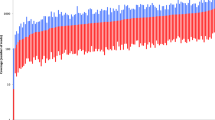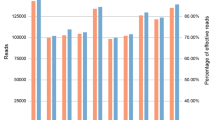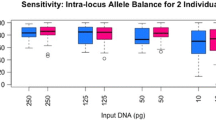Abstract
Over 5,700 three-probe VNTR DNA profiles collected by several United Kingdom (UK) laboratories have been compared to examine the probability of randomly matching 2 samples from different individuals. In over 16 million comparisons, using a matching rule corresponding to the matching guideline employed by the UK Forensic Science Service, no profiles were found to match at the 3 loci DlS7 (MS1), D7S21(MS31) and D12SI1 (MS43a). The frequency of occurrence of a set of Caucasian profiles have been estimated with 6 reference databases. The results show that there were greater differences in the frequency estimates when using a database of Afro-Caribbean or Asian profiles, rather than a different Caucasian database. The results further demonstrate the power and robustness of the VNTR DNA profiling technique for forensic casework.
Similar content being viewed by others
References
Risch NJ, Devlin B (1992) On the probability of matching DNA fingerprints. Science 255:717–720
Krane DE, Allen RW, Sawyer SA, Petrov DA, Hard D (1992) Genetic differences at four DNA typing loci in Finnish, Italian and mixed Caucasian populations. Proc Nall Acad Sci USA 89: 10583–10587
Devlin B, Kromiris T, Risch N (1993) Population genetics of the HRAS1 minisatellite locus. Am J Hum Genet 53: 1298–1305
Herrin G (1993) Probability of matching RFLP patterns from unrelated individuals. Am J Hum Genet 52: 491–497
Gill P, Evert IW, Woodroffe S, Lygo JE, Millican ES, Webster M (1991) Databases, quality control and interpretation of DNA profiling in the Home Office Forensic Science Service. Electrophoresis 12: 204–209
Evett IW, Gill P (1991) A discussion of the robustness of methods for assessing the evidential value of DNA single locus profiles in crime investigations. Electrophoresis 12: 226–230
Gill P, Woodroffe S, Lygo JE, Millican ES (1991) Population genetics of four hypervariable loci. Int J Legal Med 104: 221–227
Evert IW, Pinchin R (1991) DNA single locus profiles: tests for the robustness of statistical procedures within the context of forensic science. Int J Legal Med 104: 267–272
Evett IW, Scranage JK, Pinchin R (1992) An efficient statistical procedure for interpreting DNA single locus profiling data in crime cases. J Forensic Sci Soc 32: 307–326
Evett IW, Scranage JK, Pinchin R (1993) An illustration of the advantages of efficient statistical methods for RFLP analysis in forensic science. Am J Hum Genet 52: 498–505
National Research Council Committee on DNA Technology in Forensic Science 1992. DNA technology in forensic science. National Academy Press, Washington, DC
Author information
Authors and Affiliations
Rights and permissions
About this article
Cite this article
Lambert, J.A., Evett, I.W. & Scranage, J.K. Large scale database experiments to assess the significance of matching DNA profiles. Int J Leg Med 108, 8–13 (1995). https://doi.org/10.1007/BF01845609
Received:
Revised:
Issue Date:
DOI: https://doi.org/10.1007/BF01845609




